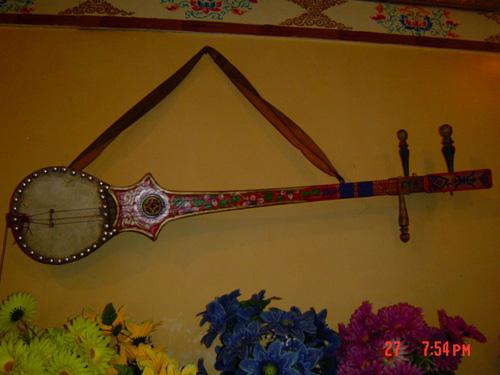The structure and material composition of Zhamunian
The traditional Jamu year is composed of the resonance box, the headstock, the piano rod, the peg, the horse and the strings, and these parts are also commonly known as the Tibetan folk.

Zhamunian is mostly made of mulberry, mahogany, walnut and sandalwood, and mahogany products are the best. The size of the piano body varies, the common ones are 100 cm to 110 cm in length.
The resonance box (commonly known as "pond" by Tibetans, the same below) is like a half-gourd-shaped cut, about 27 cm long, made of a whole piece of wood, the upper part is smaller, the inner cavity is hollowed out, the surface is prismatic, and the lower part is dug out with an oval abdominal cavity , the surface is covered with goat skin, deer skin or fish skin, and the surface is 14 cm to 16 cm wide.
On the surface of the piano above the skin, there is a meniscus-shaped sound hole ("Zamunianka", which means "Zhamunian's mouth").
A pine sound column is placed between the back and the skin in the abdominal cavity. The surface of the back is engraved with seven vertical rib patterns or glued with thin wood strips at the same position, which not only looks good, but also prevents the body from sliding when playing.
The head of the qin ("dangli", meaning "horse head") bends backwards and then forwards in a semi-circular shape, and the top is generally unadorned. There are also dragon head carvings on the head of the Zhamunian qin, which are called "long head qin" by the people.
The string groove is transparent, the peg shaft ("Jubu", meaning "tightening") is arranged in six rows on both sides (three on the left and right), and there is a mountain pass under the string groove. The piano bar is slender and hollow, and the hollow body is dug out from the front face down. The thickness of the bar wall is preferably 1.5 cm, and the mahogany fingerboard is glued on it. The surface is not graded.
Set up a wooden bridge with an empty horse and six gut strings or silk strings. For a long time, Zhamunian has maintained a simple and simple shape, and some piano bodies are still inlaid and bonded by the upper and lower pieces of wood. The exterior of the violin mostly maintains the natural color of the wood, and some paints are brown or reddish brown, and the film mostly maintains the original color or is dyed dark green.
 渝公网安备 50010702504639号
渝公网安备 50010702504639号